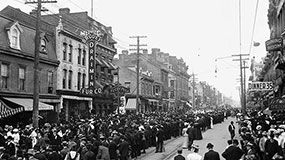
 This year marked the 141st annual Labour Day parade in Canada. Many Canadians acknowledge this holiday as the final long weekend of summer and a closing time for warm summer weather. However, the first Monday of September represents much more than barbecues, cottages, and motorboats. This holiday marks the date when twenty-seven Toronto unions organized and stood together in support of the Toronto Typographical union, who were on strike to demand the 58-hour workweek.
This year marked the 141st annual Labour Day parade in Canada. Many Canadians acknowledge this holiday as the final long weekend of summer and a closing time for warm summer weather. However, the first Monday of September represents much more than barbecues, cottages, and motorboats. This holiday marks the date when twenty-seven Toronto unions organized and stood together in support of the Toronto Typographical union, who were on strike to demand the 58-hour workweek.
To some, it is difficult to imagine a time when a twelve-hour workday required intense struggle and fighting to achieve. To others, endeavors like this are all too real. For Canada, these conflicts brought the Great White North to the forefront of history. The “Nine-Hour Movement” established its roots in Hamilton before spreading into the industrial regions of Toronto. It was in Ontario’s capital during 1869 where the typographical union sent demands to their employers to drop working hours to fifty-eight per week. The business owners, including George Brown, predictably denied the petition.
Three years later, the union bolstered their stance and threatened the businesses with a mass strike. After being deemed “absurd” by their bosses, the union initiated the strike on March 25, 1872. A solidarity rally was held on April 14, lead by marching bands and union sympathizers. By the time the rally had made it to Queen’s Park, the parade reached a staggering 10,000 participants. To combat the striking workers, the companies substituted in rural workers to man the presses, and George Brown took legal action against the striking union. This counterattack revealed that Canadian law considered Union activity such as this to be a criminal offense. As a consequence, Toronto police imprisoned twenty-four of the strike’s organizers.
Brown went too far , which ultimately proved to be a blessing. After watching the Nine-Hour Movement for some time, Sir John A. McDonald took notice of the behaviour of Brown and of the public. McDonald had an idea that would not only make a fool of his rival, Brown, but would win the political support of the workers as well. After freeing the arrested union workers, McDonald passed the trade union act which legalized and protected trade union activity. As unions were now protected, they continued to fight for nine-hour work days until, in 1872, they succeed. Annual parades in support of this victory began. In 1882 an American by the name of Peter J. McGuire attended Toronto during the day of the parade. Inspired by what he had witnessed, McGuire returned to New York. With his support, the first American “Labour Day” was held on September 5, 1882. Eventually, Sir John Thompson of Canada declared this to be an official holiday. A ripple effect occurred throughout all of Canada and the United States. In time, unions fought and won nine-hour days.
Labour Day celebration identifies the reasons for the laws that affect all labour rights. These include security, hours, breaks, and safety within one’s workplace. So next time you work a nine-hour shift or less and receive a break, thank the unions. Better yet, thank the small printer’s union that began this entire act in Toronto.

